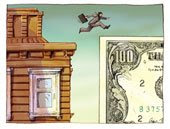 It’s pretty much a given that, every time our Trend Tracking Indexes (TTIs) have us out of the market and in money funds, somebody (a client or a reader) will ask if we can’t use the idle cash to buy some ultra-short bond funds to enhance returns.
It’s pretty much a given that, every time our Trend Tracking Indexes (TTIs) have us out of the market and in money funds, somebody (a client or a reader) will ask if we can’t use the idle cash to buy some ultra-short bond funds to enhance returns.
There are reasons why I don’t get involved in those types of securities, some of which have been addressed in “Broken Bonds,” by MarketWatch:
When it comes to investing, there are times when boring is good, when the idea is to find a safe haven in a fund that does a simple job, easily and without flash, the kind of mutual funds you can hold without fear of what happens the next time you look at your statement.
For more than a year now, however, investors who have parked money in ultra-short duration bond funds have come away feeling like their investment vehicle has been vandalized while their cash was parked.
Over the past 12 months, the average ultra-short bond fund is off 1.66%, according to fund-tracker Lipper Inc. So far this year the situation is uglier, with the average fund in the category losing around 2.2% of its value.
For some of these funds, however, damages have been far worse. SSgA Yield Plus is down 30% in 12 months through May 8. Meanwhile, Schwab YieldPlus has lost almost 29%, and Fidelity Ultra-Short Bond has taken a 12.9% haircut.
For an ultra-short bond fund, that’s as ugly as it gets. For investors, it’s important to know how this happened and how a fund that is supposedly so safe can turn out to be so dangerous.
The cause of the problems should be obvious even to casual investors, namely the subprime credit-crisis; the troubled ultra-short funds typically hold a big slug of asset-backed securities tied to the performance of the housing market.
When the housing market went into the tank, it took housing securities with it. Many institutional investors who had bought similar securities — including some hedge funds — had to either sell these investments or shut down; they opted for the former and flooded the market with notes, dropping prices even further.
Investors today clearly recognize the danger in subprime asset-backed securities, but before all of the trouble started, these securities were considered safe enough to fit into the investment profile of a risk-averse fund like an ultra-short. Money managers looking to squeeze some extra returns from the market went down the slippery slope towards subprime debt supported by the ratings agencies such as Standard & Poor’s and Moody’s Investors Service, which had test-driven the securities and given them appropriate ratings. Managers thought they were within their designated safety parameters.
So much for perceived safety! I have found over the past 25 years that when our Trend Tracking Indexes, especially the domestic one, are below their long-term trend lines, we are without fail living in times of great uncertainty.
The markets are in bear territory heading further south or aimlessly meandering and going nowhere. During that period, it’s important not to have any market risk with your idle cash. Yes, it’s tempting to try to spruce up the yield a little bit, but it simply is not worth the extra risk as many have found out over the past year.
After the bursting of the tech bubble in 2000, or now in the midst of the Subprime/credit/housing crisis, the theme remains the same: Safety of your portfolio comes first, and investments are made with clearly defined entry and exit points to control the risk.
If you want to be totally out of the market, safely on the sidelines and isolated from any risk, ultra-short bonds are not the tool to use; U.S. Treasury only funds are.
